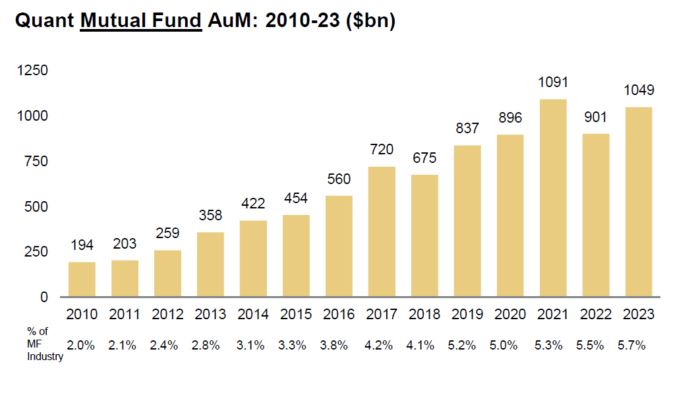How Big Can Systematic Trading Get in Credit?
This article originally appeared in The Desk here.
Investors can achieve significant advantages though systematic trading, such as reduction of trader/investor bias, and responsiveness to signals. However, there are limits to the application of systematic processes, which create boundaries to its expansion.
“Evolving the investment process to embrace quant/alt/systematic processes,” was a top five ingredient for asset management success in the report, ‘Embracing the AI Tipping Point’ published by Morgan Stanley analyst Michael Cypris et al the summer. “We see convergence of fundamental and quantitative investment processes over the next decade – boosting returns with “quantamental” approach incorporating vast amounts of new data and harnessing new AI tools.”

Source: Morgan Stanley
Systematic trading requires the same signals as systematic investment, but to paraphrase Ken Griffin, CEO of systematic giant, Citadel, “Trading is how you monetise research”. The timing and pricing of a trade reflect the success or failure of an investment strategy.
Three elements are key to adoption and growth of systematising any process; data or signal, technology, and strategy.
In credit markets, these are available in varying quantities and qualities.
“One major factor is the proliferation of reliable composite pricing sources, which now span a broad universe across investment grade, high yield and emerging markets credit,” says Izzy Conlin, head of US institutional credit, Tradeweb. “These pricing sources have made data more accessible and transparent, which has been crucial in the development and implementation of systematic trading strategies. What’s more, as confidence in pricing continues to improve, the barriers that have traditionally limited quant trading in credit markets are diminishing, making it an increasingly attractive area for credit trading.”
As data becomes increasingly available, such as US investment grade (IG) credit, often as a result of increased reporting and transparency requirements, systematic strategies are more enabled. Equally the interaction between more liquid instruments such as exchange traded funds (ETFs) and futures, allow traders to access more frequent transaction data which help in spotting and pricing trading opportunities.
“Additionally, non-bank liquidity providers are becoming more influential in shaping credit markets,” Conlin notes. “These firms are harnessing technology to enhance execution, manage risk and provide liquidity efficiently. This technological shift is creating a more favorable environment for systematic trading strategies, one that prioritizes innovation and leads with technology solutions.”
These firms create a virtuous circle as more trading, begets more data, enabling more frequent trading.
Increasing standardisation of instruments enables them to be more fungible, and that also supports their inclusion within a systematic approach. As indexes increase in number and breadth, the range of bonds captured by ETFs and futures which price those bonds increases.
This adds to the liquidity, boosting the range of buy-side firms able to develop systematic strategies, to work alongside more traditional actively managed portfolios.
“As data accessibility increases and the technological infrastructure continues to evolve, we see potential for quant trading to occupy a larger portion of the credit trading market,” says Conlin. “The potential for quant trading in credit markets is significant and growing rapidly.”
Related Content
Electronic Credit Trading Approaching Inflection Point in IG